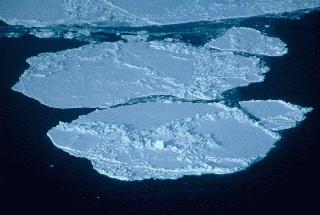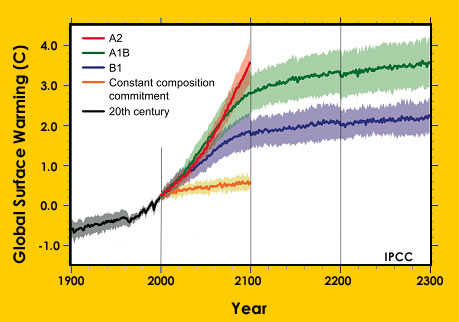Click on image for full size
Courtesy of Jack Cook, WHOI (Woods Hole Oceanographic Institute)
Arctic Ocean Currents
To understand the dynamics of the Arctic Ocean and its impact on surrounding areas and global climate, one must understand the fundamentals of the system. Cold, relatively fresh water comes into the Arctic Ocean basin from the Pacific Ocean through the Bering Strait. This water meets more fresh water from Siberian and Canadian rivers and is swept into the Beaufort gyre where winds force the water into clockwise rotation. When winds slack off and the gyre weakens, fresh water leaks out of the gyre and into the North Atlantic Ocean. It can exit the Arctic Ocean by three main pathways – the Fram, Davis, and Hudson Straits. Of course, water can go both ways, and water does come into the Arctic Ocean from the North Atlantic. This water is warmer and relatively salty. Because of its increased salinity, it is denser and sinks below Arctic waters. This seems to be the ‘normal’ long-term course of water moving into and out the Arctic region.All the while water is coming into the Arctic system, being held in the Beaufort gyre, and exiting into the North Atlantic, ice is being made at the very beginning of this process. Frigid cold air coming from the Alaskan interior freezes the water entering the Arctic just after it passes through the Bering Strait. The cold air freezes the seawater forming sea ice, and then the wind continues to push this sea ice farther into the Arctic Ocean basin, making room for more sea ice to be made. This process is often referred to as the Arctic ‘sea ice factory’. Now when sea ice is created, salt is released into the remaining non-frozen water. This surface water becomes very salty and very dense and so it sinks forming a layer known as the Halocline. The Arctic waters are thus stratified with the top layer being relatively fresh, cold water, a middle layer (the Halocline) being salty, cold water, and a third and deeper layer of warm, salty water that has entered from the Atlantic. This layering of Arctic waters is essential to the survival of sea ice in the region. Without the Halocline layer acting as a buffer, warm, salty water from the Atlantic would enter the Arctic and would begin to melt existing sea ice.
In the last decade, scientists have become increasingly aware of the Arctic region’s impact on global climate. Melting sea ice due to increasing global temperatures is a grave concern. Some fresh water flowing out of the Beaufort gyre and into the North Atlantic is expected as a result of natural processes. However, with the increase of fresh water coming from melting sea ice being added to this huge vortex, more and more fresh water is spilling out into the Atlantic, and many scientists think this could be a big problem and cause major climate shifts in North America and Western Europe. Normally, these regions have mild climates because a system of ocean currents called the Global Ocean Conveyor carries heat as well as matter around the globe, and as it passes North America and Western Europe it warms those regions by releasing heat that it picked up in the tropics. If, however, there is a larger-than-normal layer of fresh water on top of the North Atlantic Ocean, scientists believe that it might act as a barrier (just as it does in the Arctic Ocean), preventing the warmer water from releasing its heat (and therefore causing cooler temperatures in North America and Europe).
There has been a considerable focus on Arctic research in the last decade. Findings will be integral in our understanding of Arctic system dynamics as well as global ocean, atmosphere and climate projections. Now it should be noted that the Arctic region poses a lot of challenges to researchers—high winds, very low temperatures, and thick sea ice all make studying this part of the world difficult. So in exploring Arctic currents, scientists have had to be creative. From autonomous underwater vehicles that have newly developed navigation systems tailor-made for Arctic sea exploration to an experimental device designed to monitor the flow of fresh water from the Arctic to the North Atlantic, over the past decade scientists have had to adapt or invent new techniques or instruments to study the Arctic Ocean. Now a new tool -- Ice-Tethered Profilers (ITP's)—promise to give researchers a whole new way to measure temperature, salinity, and other water properties as they travel up and down a wire rope hanging down to 800 meters (~0.5 miles) into the Arctic Ocean. They can also measure surface currents as they drift through the Arctic. Although the floats won’t replace in-person measurements by scientists, they will allow year-round research in many areas that are too remote or dangerous for people (they are indeed polar bear proof!). In fact, ITP's make their measurements and send the data to computers via satellite so scientists can access the data from anywhere in the world. ITP's are just one more step forward in research that will hopefully shed more light on the Arctic Ocean, its currents, and its contributing role in regional and global climate.















